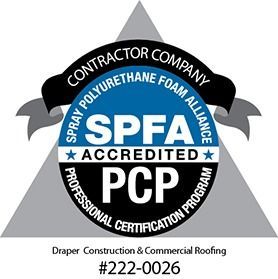Flat Roof Restoration vs. Repair: Understanding the Key Differences
At Draper Construction & Commercial Roofing, we specialize in providing high-quality roofing services to businesses and property owners throughout Oklahoma City and beyond.
One of the most common questions we receive from clients with flat roofs is whether they should pursue a restoration or repair. Both options aim to extend the lifespan of your roof, but they are very different in terms of approach, costs, and outcomes.
Here are the key differences between flat roof restoration and repair. Understanding these differences will help you make an informed decision about the best solution for your building’s roof, saving you time, money, and headaches down the road.
What is Flat Roof Repair?
Flat roof repair refers to the process of fixing specific issues or damage to a roof. Repairs are generally done on a case-by-case basis, targeting a particular problem like a leak, damaged membrane, or puncture. Flat roofs, in particular, are susceptible to wear and tear due to the lack of slope, which can lead to standing water and pooling, increasing the risk of leaks.
Common causes of damage that require repair include:
- Leaks: Water intrusion can be caused by damaged flashing, cracked seams, or worn-out materials. Leaks can be pinpointed and patched to stop the water from seeping through.
- Punctures and Tears: Roofing materials can sometimes get punctured by falling debris, foot traffic, or extreme weather conditions. These tears must be sealed to prevent further damage.
- Blisters: Flat roofs are prone to blistering, especially in areas with poor ventilation. Blisters can create areas of weakness that need to be repaired before they develop into larger issues.
- Cracked or Worn-out Seals: The seals around vents, pipes, and other roof penetrations can degrade over time, leading to leaks. These can often be repaired by replacing or resealing them.
Advantages of Flat Roof Repair:
- Cost-Effective for Minor Damage: If the damage is localized and the roof is otherwise in good condition, repairs can be more affordable than a full restoration.
- Quick and Immediate Results: Repairs can often be completed in a matter of hours or days, depending on the severity of the damage. This makes it a good option for urgent situations like a leaking roof.
- Minimal Disruption: Since repairs address specific issues, they typically cause less disruption to the building’s operations and occupants.
However, it’s important to note that repair is often a short-term solution. If your roof has widespread damage or aging materials, repairs may only provide a temporary fix, requiring frequent maintenance and potentially leading to higher costs in the long run.
What is Flat Roof Restoration?
Flat roof restoration, on the other hand, is a more comprehensive approach to extending the life of your roof. Rather than simply fixing individual problems, restoration involves applying a new protective layer over the existing roofing material to improve its overall condition and performance. The process typically involves cleaning the roof, repairing any damage, and then applying a reflective, waterproof coating to seal the entire roof.
Restoration is ideal for flat roofs that are aging but still have a solid structure. This process can rejuvenate the roof, protect it from further damage, and improve energy efficiency, especially when high-quality reflective coatings are applied.
Steps in Flat Roof Restoration:
- Inspection and Cleaning: The roof is thoroughly inspected to identify any underlying issues, such as cracks or weak spots. Once the inspection is complete, the roof is cleaned to remove debris, dirt, and old roofing materials.
- Repairs: Any damage or areas of weakness are repaired, including cracks, seams, and punctures. This ensures that the restoration process will be effective and long-lasting.
- Coating Application: A new layer of protective coating, such as silicone, acrylic, or elastomeric, is applied over the entire roof surface. These coatings seal the roof, making it waterproof and reflective, which helps with temperature regulation and energy efficiency.
Advantages of Flat Roof Restoration:
- Cost-Effective Alternative to Replacement: Restoration is typically more affordable than a full roof replacement, especially when compared to the cost of tearing off and replacing a flat roof. It also extends the life of your roof by up to 10-15 years.
- Improved Energy Efficiency: Many roof coatings are reflective, which can help lower cooling costs by reducing heat absorption. This can be a significant advantage for businesses in Oklahoma City, where summers can be particularly hot.
- Environmentally Friendly: Restoration is a more sustainable option because it reduces the need for roofing materials to be removed and disposed of. Instead, the existing roof is preserved and enhanced, keeping materials out of landfills.
- Long-Term Solution: While repairs are typically short-term fixes, restoration provides long-lasting benefits by protecting the entire roof from future damage.
Key Differences Between Flat Roof Restoration and Repair
Scope of Work:
- Repair: Targets specific problems, such as leaks or punctures, without addressing the overall condition of the roof.
- Restoration: A comprehensive process that rejuvenates the entire roof, addressing existing damage and applying a protective coating to prevent future issues.
Cost:
- Repair: More affordable for small, localized problems but may add up if there are recurring issues.
- Restoration: Generally, more expensive than a simple repair, but it offers a more cost-effective alternative to a full roof replacement, providing long-term savings.
Longevity:
- Repair: May only provide short-term relief, especially if the roof is aging or has widespread damage.
- Restoration: Can extend the lifespan of the roof for up to 10-15 years, offering a longer-term solution than repairs.
Energy Efficiency:
- Repair: Does not typically address energy efficiency.
- Restoration: Many restorations include the application of reflective coatings that improve energy efficiency by reducing heat absorption.
Disruption:
- Repair: Typically causes less disruption, as only the affected areas are worked on.
- Restoration: May involve a more extensive process, but it’s still minimally disruptive compared to a full replacement.
When to Choose Repair vs. Restoration
- Repair is best if your roof has isolated issues, such as small leaks or punctures, and is otherwise in good condition.
- Restoration is a great option if your flat roof is aging, showing signs of wear and tear, and still has structural integrity. It’s also ideal if you want to improve energy efficiency and extend the life of the roof without undergoing a complete replacement.
Whether you choose to repair or restore your roof, our experienced team at Draper Commercial Roofing & Construction is here to assess your specific needs and recommend the most effective solution.
Contact us today to schedule a roof inspection and discuss your options for flat roof repair or restoration.







